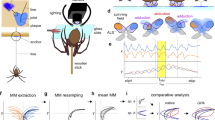Abstract
The spider Leucauge marianaprobably uses the presence of temporary spiral (TSP) lines already in place to determine sites of attachment of currently produced loops of temporary spiral, but less rigidly than has been previously supposed for orb weavers. Memory of distances and directions traveled recently to and from TSP lines is implicated by the fact that adjustments to experimental and natural discontinuities in previous TSP lines occur gradually rather than being abrupt. Distances and directions traveled along both radii and previous TSP lines correlate with relative amounts of adjustment. Body size may also be used as a reference measure, but not in the simple, inflexible way suggested by R. W. G. Hingston (A Naturalist in Himalaya,Small, Maynard, Boston, 1920). Tensions on radii are not used as cues in any simple way, and may not be used at all, since experimental changes in tensions produced effects consistent with resulting changes in thread positions but inconsistent with tension differences.
Similar content being viewed by others
References
Barth, F. G., and Seyfarth, E. A. (1971). Slit sense organs and kinesthetic orientation.Z.Vergl. Physiol. 74: 326–328.
Bell, W. J. (1985). Sources of information controlling motor patterns in arthropod local search orientation.J. Insect Physiol. 31: 837–847.
Brownell, P. H. (1984). Prey detection by the sand scorpion.Sci. Am. 251(6): 94–105.
Buchli, H. H. R. (1969). Hunting behavior in the Ctenizidae.Am. Zool. 9: 175–194.
Crawford, J. D. (1984). Orientation in a vertical plane: The use of light cues by an orb-weaving spider,Araneus diadematus Clerk.Anim. Behav. 32: 162–171.
Dawkins, R., and Dawkins, M. (1973). Decisions and the uncertainty of behaviour.Behaviour 45: 83–103.
Denny, M. (1976). The physical properties of spider's silk and their role in the design of orb webs.J. Exp. Biol. 65: 483–506.
Eberhard, W. G. (1972). The web ofUloborus diversus (Araneae: Uloboridae).J. Zool. Lond. 166: 417–465.
Eberhard, W. G. (1974). The “inverted ladder” web ofScoloderus sp. and the intermediate orb ofEustala (?) sp. (Araneidae).J. Nat. Hist. 9: 93–106.
Eberhard, W. G. (1976). Photography of orb webs in the field.Bull. Br. Arachnol. Soc. 3: 200–204.
Eberhard, W. G. (1981). Construction behaviour and the distribution of tensions in orb webs.Bull. Br. Arachnol. Soc. 5: 189–204.
Eberhard, W. G. (1982). Behavioral characteristics for the highest classification of orb-weaving spiders.Evol. 36: 1067–1095.
Eberhard, W. G. (1986). Effects of orb web geometry on prey interception and retention. In Shear, W. A. (ed.),Spiders Webs Behavior and Evolution, Stanford University Press, Palo Alto, Calif., pp. 70–100.
Eberhard, W. G. (1987a). Web-building behavior of anapid, symphytognathid, and mysmenid spiders (Araneae).J. Arachnol. (in press).
Eberhard, W. G. (1987b). Effects of gravity on temporary spiral construction byLeucauge mariana (Araneae: Araneidae).J. Ethol. (in press).
Eberhard, W. G. (1987c). Flexibility in innate behavior: Effects of gland contents on orb web design (in preparation).
Eberhard, W. G. (1987d). Imprecision in innate behavior (in preparation).
Eberhard, W. G. (1987e). Construction of the first loop of sticky spiral byLeucauge mariana (Araneae: Araneidae) (in preparation).
Görner, P. (1973). Beispiele einer Orientierung ohne richtende Aussenreize.Fortschr. Zool. 21: 20–45.
Görner, P., and Zeppenfeld, C. (1980). The runs of Pardosa amentata (Araneae, Lycosidae) after removing its cocoon.Proc. 8 Int. Cong. Arachnol., pp. 243–248.
Griffin, D. R. (1984).Animal Thinking, Harvard University Press, Cambridge, Mass.
Hingston, R. W. G. (1920).A Naturalist in Himalaya, Small, Maynard, Boston.
König, M. (1951). Beitrage zur Kenntnis des Netzbaues orbiteiler Spinnen.Z. Tierpsychol. 8: 462–492.
Land, M. F. (1985). The morphology and optics of spider eyes. In Barth, F. G. (ed.),Neurobiology of Arachnids, Springer-Verlag, New York, pp. 53–78.
LeGuelte, L. (1969). Learning in spiders.Am. Zool. 9: 145–152.
McCook, H. (1889).American Spiders and Their Spinning-work. I. Webs and Nests, Author, Philadelphia.
Peters, P. (1970). Orb web construction: Interaction of spider (Araneus diadematus Cl.) and thread configuration.Anim. Behav. 18: 478–484.
Savory, T. H. (1952).The Spider's Web, Frederick Warne, New York.
Witt, P. N. (1965). Do we live in the best of all worlds? Spider webs suggest an answer.Perspect. Biol. Med. 8: 475–487.
Witt, P. N., Reed, C. F., and Peakall, D. B. (1968).A Spider's Web, Springer Verlag, New York.
Author information
Authors and Affiliations
Rights and permissions
About this article
Cite this article
Eberhard, W.G. Memory of distances and directions moved as cues during temporary spiral construction in the spiderLeucauge mariana (Araneae: Araneidae). J Insect Behav 1, 51–66 (1988). https://doi.org/10.1007/BF01052503
Accepted:
Issue Date:
DOI: https://doi.org/10.1007/BF01052503




